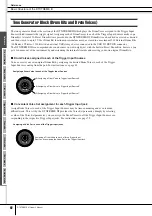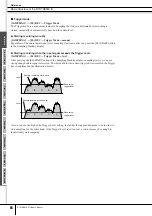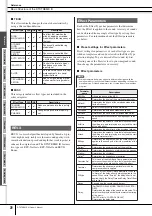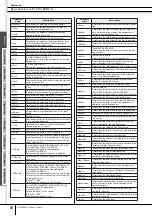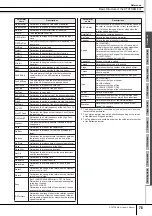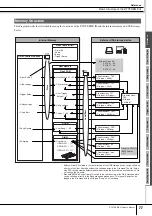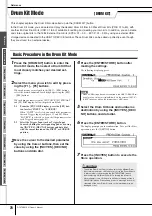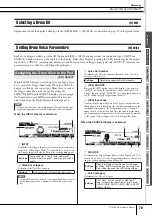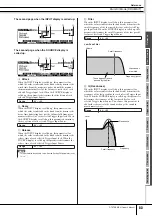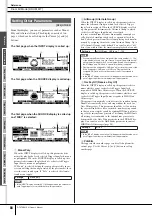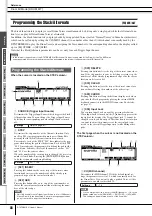
Basic Structure of the DTXTREME III
Reference
74
DTXTREME III Owner’s Manual
Ref
erence
Dr
um Kit mode
Song mode
Clic
k mode
T
rigger mode
File mode
Utility mode
Chain mode
Sampling mode
GateTime
Determines the gate time of the sliced portion.
H.Freq
Determines the center frequency of the high EQ
band that is attenuated/boosted.
H.Gain
Determines the amount of boost or attenuation
applied to the high EQ band.
Height
Determines the height of the simulated room.
HiAtk
Determines the amount of time from the moment a
note is played to the moment the compressor is
applied to the high frequencies.
HiGain
Determines the output gain for the high frequencies.
HiLvl
Determines the level of the high frequencies.
HiMute
Switches the mute status of the high frequencies.
HiRat
[For MULTI BAND COMP]
Determines the ratio of the compressor for the high
frequencies.
HiRat
[For REVERB effects]
Adjusts the resonance of the high frequencies.
HiTh
Determines the minimum input level at which the
effect is applied to the high frequencies.
HornF
Determines the speed of the horn when the slow/fast
switch is set to “fast.”
HornS
Determines the speed of the horn when the slow/fast
switch is set to “slow.”
HPF
Determines the Cutoff frequency of the High Pass
Filter.
InitDly
Determines the amount of time that elapses between
the direct, original sound and the initial reflections.
InitDly1
Determines the delay time for the 1st series.
InitDly2
Determines the delay time for the 2nd series.
InitDlyL
Determines the delay time of the left channel.
InitDlyR
Determines the delay time of the right channel.
InpLvl
Determines the input level.
InpMode
Selects mono or stereo configuration for the input
sound.
InpSelect
Selects an input.
L.Freq
Determines the center frequency of the low EQ band
that is attenuated/boosted.
L.Gain
Determines the amount of boost or attenuation
applied to the low EQ band.
L/RDiffuse
Determines the spread of the sound.
L/RDpth
Determines the depth of the L/R pan effect.
Lag
Determines the lagging time additionally applied to
the delayed sound, and is specified via a note length.
This helps in setting rhythmic effects that match the
timing of the music.
LFODpth
[For CHORUS effects, RING MODULATOR, CLAS-
SIC FLANGER, TEMPO FLANGER]
Determines the depth of the modulation.
[For TEMPO PHASER]
Determines the depth of the phase modulation.
LFOPhDiff
Determines the L/R phase difference of the modu-
lated wave.
LFOPhRst
Determines how the initial phase of the LFO is reset.
LFOSpeed
[For CHORUS effects, TREMOLO, RING MODULA-
TOR, CLASSIC FLANGER, TEMPO FLANGER]
Determines the frequency of the modulation.
[For TEMPO PHASER]
Determines the modulation speed via a note length.
This helps in setting rhythmic effects that match the
timing of the music.
[For AUTO PAN]
Determines the frequency of the Auto Pan.
LFOWave
[For CLASSIC FLANGER, RING MODULATOR]
Selects the wave for modulation.
[For AUTO WAH]
Selects the wave, sine or square.
[For AUTO PAN]
Determines the panning curve.
Paramater
name
Descriptions
Livenss
Determines the decay characteristics of Early Reflec-
tion.
LowAtk
Determines the amount of time from the moment a
note is pressed to the moment the compressor is
applied to the low frequencies.
LowGain
Determines the output gain for the low frequencies.
LowLvl
Determines the output level for the low frequencies.
LowMute
Determines whether the low frequency band is off or
on.
LowRat
[For MULTI BAND COMP]
Determines the ratio of the compressor for the low
frequencies.
LowRat
[For REVERB effects]
Determines the ratio of the low frequencies.
LowTh
Determines the minimum input level at which the
effect is applied to the low frequencies.
LPF
Determines the cutoff frequency of the low pass filter.
LPFReso
Determines the Resonance of the Low Pass Filter for
the input sound.
M.Freq
Determines the center frequency of the middle EQ
band that is attenuated/boosted.
M.Gain
Determines the amount of boost or attenuation
applied to the middle EQ band.
M.Width
Determines the width of the middle EQ band.
Manual
[For FLANGER]
Determines the offset value of the delay modulation.
[For PHASER MONO, PHASER STEREO]
Determines the offset value of the phase modulation.
MicAngl
Determines the L/R angle of the microphone.
MidAtk
Determines the amount of time from the moment a
note is pressed to the moment the compressor is
applied to the mid frequencies.
MidGain
Determines the output gain for the mid frequencies.
MidLvl
Determines the output level for the mid frequencies.
MidMute
Switches the mute status of the mid frequencies.
MidRat
Determines the ratio of the compressor for the mid
frequencies.
MidTh
Determines the minimum input level at which the
effect is applied for the mid frequencies.
Mix
Determines the volume of the effect sound.
MixLvl
Determines the level of the effect sound mixed to the
dry sound.
ModDpth
Determines the depth of the modulation.
ModDptR
Determines the depth of the modulation for the right
channel as offset.
Mode
Determines the phaser type, or more specifically, the
factor for forming the phaser effect.
ModFB
Determines the feedback level to the modulation.
ModGain
Determines the gain of the modulation.
ModLPF
Determines the cutoff frequency of the low pass filter
applied to the modulated sound.
ModLPFReso
Determines the resonance of the low pass filter for
the modulated sound.
ModMix
Determines the mix balance of the modulated ele-
ment.
ModPh
Determines the L/R phase difference of the modu-
lated wave.
ModSpd
Determines the modulation speed.
ModWave
Selects the wave type for modulation.
MoveSpeed
Determines how long it takes to move the sound from
the current status to the sound specified via the
Vowel parameter.
NoiseQ
Determines the resonance of the low pass filter
applied to the noise.
NoisLPF
Determines the cutoff frequency of the low pass filter
applied to the noise.
NoisLvl
Determines the noise level.
Paramater
name
Descriptions
Содержание DTXTREME III
Страница 1: ...EN OWNER S MANUAL ...



